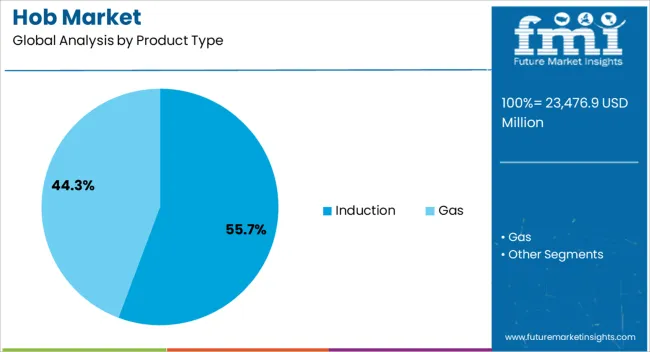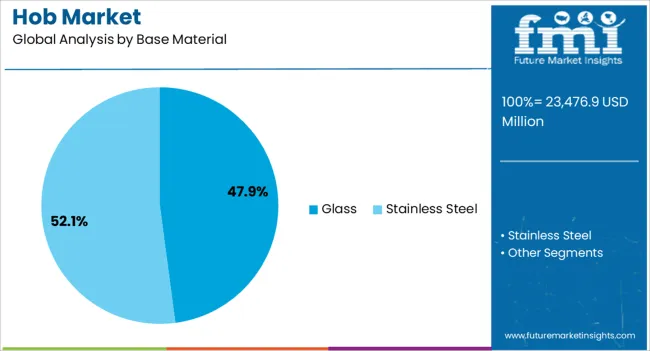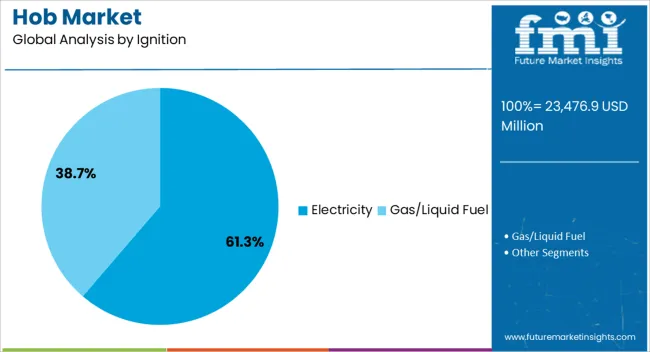The Hob Market is estimated to be valued at USD 23476.9 million in 2025 and is projected to reach USD 36809.4 million by 2035, registering a compound annual growth rate (CAGR) of 4.6% over the forecast period.
The hob market is experiencing steady growth, driven by the evolution of modern kitchen designs, rising consumer preference for energy-efficient cooking appliances, and increasing adoption of built-in cooking systems. Industry announcements and appliance manufacturer reports have emphasized the shift toward modular kitchens, where hobs offer both functional benefits and aesthetic appeal.
The demand for smart kitchen solutions has further boosted the market, with newer hobs featuring touch controls, programmable settings, and safety sensors. Government programs promoting energy-efficient appliances and the phasing out of traditional gas-based stoves in certain regions have supported the transition toward electric and induction-based hobs.
Additionally, lifestyle changes and growing urbanization in emerging economies have increased the demand for space-saving and high-performance kitchen appliances. Continuous product innovation, including the integration of premium materials such as glass and ceramic, has enhanced durability and ease of cleaning. Looking ahead, segmental growth is expected to be driven by rising preference for induction hobs, the expanding use of glass as a base material, and the dominant reliance on electricity for ignition systems.

| Metric | Value |
|---|---|
| Hob Market Estimated Value in (2025 E) | USD 23476.9 million |
| Hob Market Forecast Value in (2035 F) | USD 36809.4 million |
| Forecast CAGR (2025 to 2035) | 4.6% |
The market is segmented by Product Type, Base Material, Ignition, Burner/Induction Zone, Price Range, and Sales Channel and region. By Product Type, the market is divided into Induction and Gas. In terms of Base Material, the market is classified into Glass and Stainless Steel. Based on Ignition, the market is segmented into Electricity and Gas/Liquid Fuel. By Burner/Induction Zone, the market is divided into Four Burners, Two Burners, Three Burners, Five Burners, and Six Burners. By Price Range, the market is segmented into USD 211 to USD 419, Less Than USD 210, USD 420 to USD 629, and USD 630 to USD 838. By Sales Channel, the market is segmented into Specialty Retail Stores, Hypermarkets, Supermarkets, Multi-Brand Stores, Online, Company Websites, and 3rd Party Online Platforms. Regionally, the market is classified into North America, Latin America, Western Europe, Eastern Europe, Balkan & Baltic Countries, Russia & Belarus, Central Asia, East Asia, South Asia & Pacific, and the Middle East & Africa.

The Induction segment is projected to capture 55.7% of the hob market revenue in 2025, maintaining its position as the leading product type. Growth of this segment has been driven by increasing consumer demand for faster, safer, and more energy-efficient cooking methods. Induction hobs operate through electromagnetic technology, which enables precise temperature control and significantly reduces cooking time.
Appliance industry insights have highlighted that induction models offer superior energy conversion efficiency compared to gas or electric coil options, resulting in lower utility costs. Additionally, the cool-to-touch surface and automatic shut-off features have made induction hobs a preferred choice for households prioritizing safety.
Manufacturers have further expanded this segment through sleek, integrated designs that cater to modern kitchen aesthetics. As energy regulations tighten and awareness of eco-conscious cooking practices increases, the Induction segment is expected to remain the dominant choice across global residential and commercial kitchens.

The Glass segment is expected to contribute 47.9% of the hob market revenue in 2025, leading the base material category. This dominance has been supported by the material’s aesthetic appeal, heat resistance, and ease of maintenance, which have aligned well with consumer expectations for both functionality and kitchen design.
Appliance manufacturer updates and consumer reviews have emphasized the popularity of tempered glass surfaces for their glossy finish, durability, and stain resistance. Furthermore, glass hobs have enabled the integration of advanced control interfaces such as touch panels and LED indicators, enhancing the overall user experience.
The premium look and minimalistic style offered by glass-based hobs have made them particularly attractive in urban kitchens and luxury apartments. As design-forward appliances continue to shape consumer preferences, and as manufacturers improve the strength and safety of glass surfaces, the Glass segment is anticipated to sustain its leading position in the base material category.

The Electricity segment is projected to hold 61.3% of the hob market revenue in 2025, emerging as the dominant ignition source. This segment’s expansion has been influenced by the global electrification of residential infrastructure and the growing push towards reducing dependency on fossil fuels for indoor energy needs.
Electric ignition systems offer convenience, quick startup, and improved safety over traditional flame ignition methods, particularly in induction and electric hobs. Reports from appliance innovation forums and energy policy frameworks have indicated that electricity-powered hobs support better energy management, especially when integrated with smart meters or home automation systems.
Moreover, electricity-based ignition has enabled the development of compact, plug-and-play hob models suited for urban apartments and portable cooking setups. With the ongoing shift towards renewable electricity sources and improved grid access in developing regions, the Electricity segment is expected to consolidate its leadership, driven by its compatibility with evolving home energy systems and future-ready appliance infrastructure.
Cloud Kitchens Influence Hob Market with Digital and Portable Innovations
The rising trend of small-scale businesses like cloud kitchens is estimated to play a significant role in the sector. The increasing digitalization and growing popularity of online shopping are boosting internet usage and are predicted to have a positive impact on the household sector for cooktops.
Portable products are gaining popularity in the sector in large numbers. Many electrical appliances are becoming portable, and the advantage of this is that their portability enables them to be transported anywhere. Advanced features and applications like automatic turn-off with dual burners are driving growth.
High Costs of Hobs Challenge Market Appeal, Impacting Consumer Choices
The high cost of the product can be a restraining factor in the industry, especially for the foremost consumer group in economics. Consumers are concerned about energy consumption, which is impacting the demand for energy-efficient stoves. Cooking habits vary across multiple regions, with some preferring induction hobs and others opting for gas or electric hobs.
Due to the high price, consumers are moving to other affordable cooktop options, which might pull demand away from residential hobs. These stoves require regular cleaning, with glass or ceramic hobs being delicate and gas burners needing periodic cleaning. Consumers who find maintenance cumbersome may opt for simpler alternatives, hindering growth.
Smaller Hobs with Advanced Features Take Center Stage as Manufacturers Prioritize Affordability
Manufacturers are focusing on reducing the price of stoves by investing in research and development. This also helps to increase their production, which is useful for targeting the low-economic group. Industries are working on smaller structural stoves to reduce the space utilization in kitchens.
With their small size and fully moderated features, they aim to attract consumers and ensure consumer safety, especially after multiple incidents. These stoves also offer the child lock application, contributing to the industry's success.
The hob market experienced a CAGR of 2.9% from 2020 to 2025, magnifying the industry growth of Hob market and extending to the value of USD 22,444.5 million in 2025. In the past estimated period, the stoves were not developed to appropriate levels with advancing features, limiting their use for specific purposes.
Although the arrival of the hobs is not up to the mark, industrialists significantly support and focus on developments within the research department.
To grow the popularity of the brand, cooker top have introduced products with multiple advanced features, including low prices, to target the low-income segment and provide a wide range of stove sections to impress and attract consumers. Additionally, they enhance benefits like easy transport and modernize the product as per customer requirements.
The hob market focuses on individual factors and domestic regulation changes, which affect current and future trends. Data points such as consumption volumes, production sites, import-export analysis, price trends, raw material costs, and value chain analysis are used to forecast industry scenarios for individual countries.
With the increasing utilization of eCommerce sites, customers can find a variety of products and compare them with the information provided by brands. To reduce competition from these online shopping sites, manufacturers are creating strategic partnerships and announcing products with improved features or applications to enhance their brand portfolios.
The forecast analysis of the hob market includes key countries of North America, Asia Pacific, and Europe. India is expected to remain the top player in Asia Pacific with a CAGR of 9% through 2035, followed by China with an 8.3% CAGR. Australia is also set to climb the ladder of success in the industry with a 6.1% CAGR.
| Countries | CAGR 2025 to 2035 |
|---|---|
| United state | 2.8% |
| Germany | 3.7% |
| China | 8.3% |
| India | 9% |
| Australia | 6.1% |
The industry is projected to register a CAGR value of 2.8% through 2035 in the United States. The population in the United States is experiencing a shift in lifestyle dynamics, with people opting for remote work and preferring to spend more time at home.
This shift has sparked a renewed interest in cooking, decoration, and improving home interior projects, which has pushed the demand for kitchen appliances such as hobs.
In the United States, individuals are spending on renovating accommodations, magnifying their culinary interest and making stoves essential components. However, stoves provide versatility and efficiency, making them the preferred choice and surging demand, leading to sector expansion.
The hob market is anticipated to register a CAGR of 9% through 2035 in India. The industry has experienced significant growth here, boosted by urbanization, modernization, and the evolution of culinary choices.
The increasing urbanization in India and the numerous people migrating to cities in search of better opportunities are key factors. Additionally, with these changes, people are placing more importance on adopting transformations in lifestyle, with a significant emphasis on modern convenience and efficiency.
This shift is impacting the sectors of kitchen appliances, especially the popularity of stoves. The cultural shift towards highly westernized culinary practices is enhancing advanced cooking technologies such as hobs.
The industry in China is set to register a CAGR of 8.3% during the forecast period. China's economic prosperity is a main component of the continuous rise in affluence of its population. The rising interest in modern cooking essentials and Western cuisine and cooking techniques is surged by globalization and exposure to international culinary trends.
China's popular search to replicate the culinary experience at home has led to the adoption of advanced developed technologies that enhance the demand for cooker tops, which are important for gourmet cooking. Government agencies are investing in industry expansion. China has witnessed exponential growth, providing multiple opportunities for industries and retailers.
The gas product type segment is estimated to dominate the hob market. The segment is anticipated to hold around 74.5% industry share in 2025. Glass-based hobs are predicted to capture an industry share of 32.2%.
| Segment | Gas (Product Type) |
|---|---|
| Value Share (2025) | 74.5% |
Hobs are utilized in various forms in gas stoves. There are multiple varieties available in hobs, which are characterized by 3 burners, 2 burners, and others. There are technological advancements and innovations of new products that upgrade the stove with advanced features to work more smartly and efficiently. These advancements make things automatic and allow people to easily operate them from their smartphones.
Industry players are focusing on investing in research and development to make things easier to operate and enhance the appearance of the gas stove. These innovations have flourished the industry's processes and raised the demand for the production of stoves, gaining popularity among consumers.
| Segment | Glass (Base Material) |
|---|---|
| Value Share (2025) | 32.2% |
The innovation in home decoration, particularly in kitchen culinary items, is moving toward modern aesthetics. There are a variety of hobs available in multiple materials, and one of them is glass, which attracts contemporary population. Glass hobs offer smooth surfaces and a sleek, modern look to the kitchen.
Glass stoves conduct heat efficiently, which is important for even cooking. With advanced technology, some glass cooker tops have impressive features like indicator lights to show when the surface is still hot and even provide child locks. They are easy to clean compare to traditional steel burners.

In the competitive landscape, this section presents a detailed overview of the competitors' activities aimed at staying ahead in the hob market. The actions include heavy investment in research and development to enhance product quality and innovation, upgrading features and applications to expand sales. Key competitors are launching products that impact their brand portfolios and meet customer requirements.
Key players are collaborating with multiple brands as a strategic move to reduce competition and promote products by combining ideas from collaborative brands.
This enhances the manufacturing process and targets a wide range of the population by expanding distribution channels. Start-ups are focusing on partnerships with large-scale hob manufacturers to offer a variety of products in different materials and capacities of stoves.
Industry Updates
Based on product type, the industry is bifurcated into gas and induction.
Depending on the material, the industry is divided into glass and stainless steel.
Electricity and gas/liquid fuel are the primary sources of ignition for hobs.
Based on the burner/induction zone, the industry is categorized into two burners, three burners, four burners, five burners, and six burners.
Hobs are available in multiple price ranges, starting from priced less than USD 210, priced from USD 211 to USD 419, priced from USD 420 to USD 629, and priced from USD 630 to USD 838.
Hobs are sold through multiple sales channels, including hypermarkets, supermarkets, multi-brand stores, specialty retail stores, online, company websites, and 3rd party online platforms.
Regional analysis of the industry includes key countries of North America, Latin America, Europe, East Asia, South Asia, Oceania, and Middle East & Africa.
The global hob market is estimated to be valued at USD 23,476.9 million in 2025.
The market size for the hob market is projected to reach USD 36,809.4 million by 2035.
The hob market is expected to grow at a 4.6% CAGR between 2025 and 2035.
The key product types in hob market are induction and gas.
In terms of base material, glass segment to command 47.9% share in the hob market in 2025.






Full Research Suite comprises of:
Market outlook & trends analysis
Interviews & case studies
Strategic recommendations
Vendor profiles & capabilities analysis
5-year forecasts
8 regions and 60+ country-level data splits
Market segment data splits
12 months of continuous data updates
DELIVERED AS:
PDF EXCEL ONLINE
Competitive Landscape of Hob Market Share
Orthobiologics Market is segmented by Product Type and End User from 2025 to 2035
Psychobiotic Supplements Market Outlook - Growth, Demand & Forecast 2025 to 2035
Hydrophobic Coating Market Forecast and Outlook 2025 to 2035
Hydrophobing Agents Market Size and Share Forecast Outlook 2025 to 2035
Hydrophobic Paper Market Report – Demand, Trends & Industry Forecast 2025-2035
Hydrophobic Interaction Chromatography Resins Market
Built-In Hobs Market Analysis – Growth & Demand Forecast 2025 to 2035
Induction Hob Market Size and Share Forecast Outlook 2025 to 2035
Residential Hobs Market Analysis - Trends, Growth & Forecast 2025 to 2035
Portable Induction Hobs Market Trends & Forecast 2025 to 2035

Thank you!
You will receive an email from our Business Development Manager. Please be sure to check your SPAM/JUNK folder too.
Chat With
MaRIA